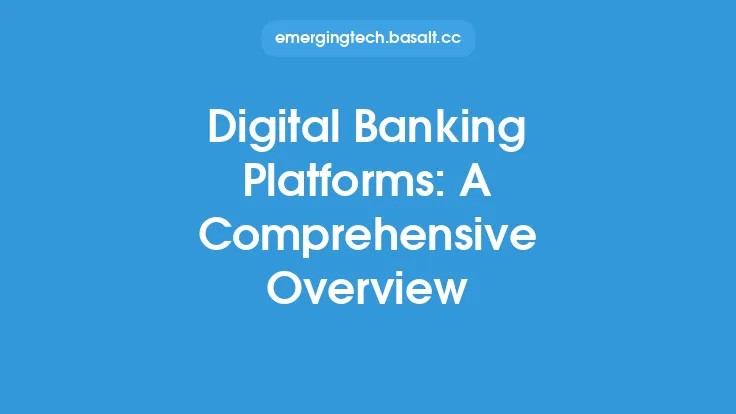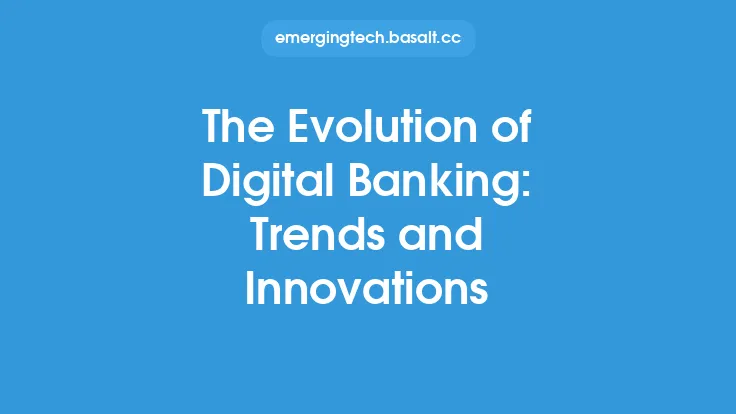The rise of digital banking has transformed the way customers interact with financial institutions, and the key to success lies in creating a seamless interface that meets the evolving needs of users. A well-designed digital banking platform can enhance customer experience, increase engagement, and drive business growth. In this article, we will delve into the world of digital banking and explore the essential elements of creating a seamless interface that delights customers and sets financial institutions apart from the competition.
Introduction to Digital Banking
Digital banking refers to the online and mobile banking services offered by financial institutions, allowing customers to manage their accounts, pay bills, transfer funds, and access various financial products and services remotely. The digital banking landscape has undergone significant changes in recent years, driven by advances in technology, changing customer behaviors, and the emergence of new players in the market. As a result, financial institutions must adapt to these changes and prioritize customer experience to remain competitive.
Key Components of a Seamless Digital Banking Interface
A seamless digital banking interface is built on several key components, including user experience (UX) design, user interface (UI) design, security, and functionality. UX design focuses on creating an intuitive and user-friendly experience, while UI design ensures that the visual elements are aesthetically pleasing and consistent with the brand's identity. Security is a critical aspect of digital banking, as customers expect their financial information to be protected from unauthorized access and cyber threats. Functionality refers to the range of services and features offered through the digital banking platform, such as account management, payment processing, and financial planning tools.
The Role of UX Design in Digital Banking
UX design plays a vital role in creating a seamless digital banking interface, as it directly impacts how customers interact with the platform. A well-designed UX can simplify complex financial tasks, reduce friction, and increase customer satisfaction. To achieve this, financial institutions should conduct thorough user research, gather feedback, and test their digital banking platforms to identify areas for improvement. Additionally, UX designers should apply human-centered design principles, such as empathy, simplicity, and consistency, to create an intuitive and engaging experience.
Technical Requirements for Digital Banking
From a technical perspective, digital banking platforms require a robust infrastructure to support high volumes of transactions, ensure scalability, and maintain security. This includes investing in cloud-based technologies, such as cloud computing and storage, to enable flexibility and cost-effectiveness. Application programming interfaces (APIs) are also essential for integrating third-party services, such as payment gateways and data analytics tools, to enhance the digital banking experience. Furthermore, financial institutions should adopt agile development methodologies, such as DevOps and continuous integration, to facilitate rapid deployment and iteration of new features and services.
Security Measures in Digital Banking
Security is a top priority in digital banking, as customers expect their financial information to be protected from unauthorized access and cyber threats. To address this, financial institutions should implement robust security measures, such as encryption, firewalls, and intrusion detection systems. Multi-factor authentication (MFA) and one-time passwords (OTPs) can also be used to add an extra layer of security and prevent phishing attacks. Moreover, financial institutions should conduct regular security audits, penetration testing, and vulnerability assessments to identify and address potential weaknesses in their digital banking platforms.
The Importance of Customer Feedback and Testing
Customer feedback and testing are crucial components of creating a seamless digital banking interface. Financial institutions should collect feedback through various channels, such as surveys, focus groups, and social media, to understand customer needs and preferences. This feedback can be used to inform design decisions, prioritize feature development, and identify areas for improvement. Additionally, financial institutions should conduct thorough testing, including usability testing, accessibility testing, and performance testing, to ensure that their digital banking platforms meet the highest standards of quality and reliability.
Best Practices for Digital Banking
To create a seamless digital banking interface, financial institutions should follow best practices, such as prioritizing simplicity and clarity, using intuitive navigation and search functionality, and providing personalized experiences through data analytics and machine learning. They should also ensure that their digital banking platforms are accessible on a range of devices, including desktops, laptops, tablets, and smartphones, to cater to different customer preferences and behaviors. Moreover, financial institutions should maintain transparency and communicate clearly with customers about changes to their digital banking platforms, such as updates, outages, and security incidents.
Conclusion
Creating a seamless digital banking interface is essential for financial institutions to remain competitive and meet the evolving needs of customers. By prioritizing UX design, security, functionality, and customer feedback, financial institutions can build trust, increase engagement, and drive business growth. As the digital banking landscape continues to evolve, financial institutions must stay ahead of the curve by investing in emerging technologies, such as artificial intelligence, blockchain, and the Internet of Things (IoT), to create innovative and personalized experiences that delight customers and set them apart from the competition.





